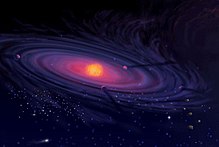Primeval cloud
The primordial cloud was an extensive molecular cloud that existed in the Milky Way about 4.6 billion years ago . By gravitational contraction took thousands from this cloud of star systems , including our solar system .
In historical hypotheses , nebula- like structures were referred to as the origin of stars and our planetary system also referred to as primordial nebula .
Size and composition
The primordial cloud adopted today had a size of about 20 parsecs . It consisted of 98 to 99% of the gases hydrogen and helium as well as micrometer- sized dust particles . These are made up of heavier elements and compounds such as water , carbon monoxide , carbon dioxide , other carbon compounds , ammonia and silicon compounds. The hydrogen and the vast majority of helium were already at the Big Bang created the heavier elements and compounds were from Nova - and supernova explosions earlier than star stardust been released.
contraction
Due to its own gravity , the primordial cloud contracted into individual fragments that condensed. These fragments were initially around 1 parsec (just over three light years ) in size and then collapsed into dense nuclei around 0.01 to 0.1 parsec (2,000 to 20,000 AU ) in size. The trigger for this fragmentation could have been the explosion of a relatively close supernova, whose pressure waves traveled through the cloud. Since only heavy, short-lived stars become supernovae, it is assumed that the region could have resembled the Orion Nebula . Studies of the Kuiper Belt suggest that our Sun was formed in a star cluster of around 1,000 to 10,000 stars, with a total mass of around 3,000 solar masses . This star cluster dissolved into free single or double stars after a few hundred million years .
The sun mist
The fragment of the primordial cloud from which our solar system was formed initially contracted to form a rotating accretion disk - the solar nebula . Since the angular momentum has to be retained during the contraction , an already minimal rotation of the collapsing fog has increased, similar to how a figure skater achieved a faster rotation by putting on her arms as a pirouette effect . The resulting centrifugal forces acting outwards led to the shape of the accretion disk.
Almost all of the matter in the solar nebula fell into the center and formed a protostar that continued to collapse. Inside this gas body, pressure and temperature rose until a nuclear fusion process was ignited, in which hydrogen nuclei fuse to form helium nuclei. The energy released in the process generated a radiation pressure that counteracted gravitation and stopped further contraction. A stable star - the sun - was formed.
A protoplanetary disk rotated around the star , from which the planets and other celestial bodies of the solar system eventually formed.
History of science
The idea that the celestial bodies of the solar system were created by natural forces of attraction and repulsion from matter scattered in the universe was first expressed by the German philosopher Immanuel Kant in his work General Natural History and Theory of Heaven in 1755 . It assumed a primordial nebula from which planetary and star systems periodically condense and disperse again. However, Kant's work received little attention for 100 years.
Independently of Kant, the French physicist and astronomer Pierre-Simon Laplace published his nebular hypothesis in his work Exposition du systeme du monde (Representation of the world system) in 1796 . Laplace assumed that there was already a heated sun, from which gas nebulae would eventually have detached and again condensed into planets.
Both theories are together called the Kant-Laplace theory . They are accorded great importance in terms of philosophy and the history of science , since they tried to explain the origin of the planetary system without the aid of a supernatural force of order, such as a god .
The term primeval cloud was originally only used for the solar nebula. More recent astronomical findings led to the image of the much larger primeval cloud, from which not only our solar system but thousands of star systems originate.
literature
- Michael A. Zeilik, Stephen A. Gregory: Introductory Astronomy & Astrophysics , 4th. Edition, Saunders College Publishing, 1998, ISBN 0-03-006228-4 .
Individual evidence
- ^ Thierry Montmerle, Jean-Charles Augereau, Marc Chaussidon: Solar System Formation and Early Evolution: the First 100 Million Years . In: Springer (Ed.): Earth, Moon, and Planets . 98, No. 1-4, 2006, pp. 39-95. bibcode : 2006EM & P ... 98 ... 39M . doi : 10.1007 / s11038-006-9087-5 .
- ↑ J. Jeff Hester, Steven J. Desch, Kevin R. Healy, Laurie A. Leshin: The Cradle of the Solar System . In: Science . 304, No. 5674, May 21, 2004, pp. 1116-1117. bibcode : 2004Sci ... 304.1116H . doi : 10.1126 / science.1096808 . PMID 15155936 .
- ↑ Martin Bizzarro, David Ulfbeck, Anne Trinquier, Kristine Thrane, James N. Connelly, Bradley S. Meyer: Evidence for a Late Supernova Injection of 60 Fe into the Protoplanetary Disk . In: Science . 316, No. 5828, 2007, pp. 1178-1181. bibcode : 2007Sci ... 316.1178B . doi : 10.1126 / science.1141040 . PMID 17525336 .
- ^ Morgan Kelly: Slow-Moving Rocks Better Odds That Life Crashed to Earth from Space . News at Princeton. Retrieved December 28, 2012.
- ↑ Simon F. Portegies Zwart: The Lost Siblings of the Sun . In: Astrophysical Journal . 696, No. L13-L16, 2009, p. L13. arxiv : 0903.0237 . bibcode : 2009ApJ ... 696L..13P . doi : 10.1088 / 0004-637X / 696/1 / L13 .

